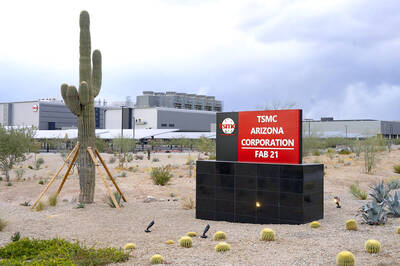When millionaire Steve Fossett’s plane went missing over the Nevada range in 2007, the swashbuckling adventurer had already been the subject of two prior emergency rescue operations thousands of miles apart.
And that prompted a prickly question: After a sweeping search for the wealthy risktaker ended, who should foot the bill?
In recent days, the massive hunt for a submersible vehicle lost during a north Atlantic descent to explore the wreckage of the Titanic has refocused attention on that conundrum. And with rescuers and the public fixated first on saving and then on mourning those aboard, it has again made for uneasy conversation.

Photo: AP
“Five people have just lost their lives and to start talking about insurance, all the rescue efforts and the cost can seem pretty heartless — but the thing is, at the end of the day, there are costs,” said Arun Upneja, dean of Boston University’s School of Hospitality Administration and a researcher on tourism.
“There are many people who are going to say, ‘Why should the society spend money on the rescue effort if (these people) are wealthy enough to be able to ... engage in these risky activities?’”
That question is gaining attention as very wealthy travelers in search of singular adventures spend big to scale peaks, sail across oceans and blast off for space.

Photo: AP
The US Coast Guard declined Friday to provide a cost estimate for its efforts to locate the Titan, the submersible investigators say imploded not far from the world’s most famous shipwreck. The five people lost included a billionaire British businessman and a father and son from one of Pakistan’s most prominent families. The operator charged passengers US$250,000 each to participate in the voyage.
“We cannot attribute a monetary value to Search and Rescue cases, as the Coast Guard does not associate cost with saving a life,” the agency said.
While the Coast Guard’s cost for the mission is likely to run into the millions of dollars, it is generally prohibited by federal law from collecting reimbursement related to any search or rescue service, said Stephen Koerting, a US attorney in Maine who specializes in maritime law.
But that does not resolve the larger issue of whether wealthy travelers or companies should bear responsibility to the public and governments for exposing themselves to such risk.
“This is one of the most difficult questions to attempt to find an answer for,” said Pete Sepp, president of the National Taxpayers Union, noting scrutiny of government-funded rescues dating back to British billionaire Richard Branson’s hot air balloon exploits in the 1990s.
“This should never be solely about government spending, or perhaps not even primarily about government spending, but you can’t help thinking about how the limited resources of rescuers can be utilized,” Sepp said.
The demand for those resources was spotlighted in 1998 when Fossett’s attempt to circle the globe in a hot air balloon ended with a plunge into the ocean 804km off Australia. The Royal Australian Air Force dispatched a Hercules C-130 transport aircraft to find him. A French military plane dropped a 15-man life raft to Fossett before he was picked up by a passing yacht.
Critics suggested Fossett should pay the bill. He rejected the idea.
Late that same year the US Coast Guard spent more than US$130,000 to rescue Fossett and Branson after their hot air balloon dropped into the ocean off Hawaii. Branson said he would pay if the Coast Guard requested it, but the agency didn’t ask.
Nine years later, after Fossett’s plane vanished over Nevada during what should have been a short flight, the state National Guard launched a months-long search that turned up the wreckage of several other decades-old crashes without finding the millionaire.
The state said the mission had cost taxpayers US$685,998, with US$200,000 covered by a private contribution. But when the administration of Governor Jim Gibbons announced that it would seek reimbursement for the rest, Fossett’s widow balked, noting she had spent US$1 million on her own private search.
“We believe the search conducted by the state of Nevada is an expense of government in performance of government action,” a lawyer wrote on behalf of the Fossett estate.
Risky adventurism is hardly unique to wealthy people.
The pandemic drove a surge in visits to places like national parks, adding to the popularity of climbing, hiking and other outdoor activities. Meanwhile, the spread of cellphones and service has left many feeling that if things go wrong, help is a call away.
Some places have laws commonly referred to as “stupid motorist laws,” in which drivers are forced to foot the emergency response bill when they ignore barricades on submerged roads. Arizona has such a law, and Volusia County in Florida, home to Daytona, enacted similar legislation this week. The idea of a similar “stupid hiker law” is a regularly debated item in Arizona as well, with so many unprepared people needing to be rescued in stifling triple-digit heat.
Most officials and volunteers who run search efforts are opposed to charging for help, said Butch Farabee, a former ranger who participated in hundreds of rescue operations at the Grand Canyon and other national parks and has written several books on the subject.
Searchers are concerned that if they did charge to rescue people “they won’t call for help as soon as they should and by the time they do it’s too late,” Farabee said.
The tradeoff is that some might take that vital aid for granted. Farabee recounts a call in the 1980s from a lawyer who underestimated the effort needed to hike out of the Grand Canyon. The man asked for a helicopter rescue, mentioning that he had an important meeting the following day. The ranger rejected that request.
But that is not an option when the lives of adventurers, some of them quite wealthy, are at extreme risk.
At Mount Everest, it can cost tens of thousands of dollars in permit and expedition fees to climb. A handful of people die or go missing while hiking the mountain every year — prompting emergency response from local officials.
While the government of Nepal requires that climbers have rescue insurance, the scope of rescue efforts can vary widely, with Upneja estimating that some could cost “multiple dozens of thousands of dollars.”
Nepal’s Ministry of Foreign Affairs did not respond to a message seeking comment.
On the high seas, wealthy yachtsmen seeking speed and distance records have also repeatedly required rescue when their voyages run astray.
When the yacht of Tony Bullimore, a British millionaire on a round-the-world journey, capsized 1,400 miles off the Australia Coast in 1997 it seemed he might be done for. Clinging to the inside of the hull, he ran out of fresh water and was almost out of air.
When a rescue ship arrived, he swam desperately toward the surface.
’I was starting to look back over my life and was thinking, ‘Well, I’ve had a good life, I’ve done most of the things I had wanted to,” Bullimore said afterward. “If I was picking words to describe it, it would be a miracle, an absolute miracle.
Australian officials, whose forces rescued a French yachtsman the same week, were more measured in their assessment.
“We have an international legal obligation,” Ian McLachlan, the defense minister said. “We have a moral obligation obviously to go and rescue people, whether in bushfires, cyclones or at sea.”
Less was said, however, about the Australian government’s request to restrict the routes of yacht races — in hopes of keeping sailors to areas where they might require less rescuing.

Taiwanese chip-making giant Taiwan Semiconductor Manufacturing Co (TSMC) plans to invest a whopping US$100 billion in the US, after US President Donald Trump threatened to slap tariffs on overseas-made chips. TSMC is the world’s biggest maker of the critical technology that has become the lifeblood of the global economy. This week’s announcement takes the total amount TSMC has pledged to invest in the US to US$165 billion, which the company says is the “largest single foreign direct investment in US history.” It follows Trump’s accusations that Taiwan stole the US chip industry and his threats to impose tariffs of up to 100 percent

On a hillside overlooking Taichung are the remains of a village that never was. Half-formed houses abandoned by investors are slowly succumbing to the elements. Empty, save for the occasional explorer. Taiwan is full of these places. Factories, malls, hospitals, amusement parks, breweries, housing — all facing an unplanned but inevitable obsolescence. Urbex, short for urban exploration, is the practice of exploring and often photographing abandoned and derelict buildings. Many urban explorers choose not to disclose the locations of the sites, as a way of preserving the structures and preventing vandalism or looting. For artist and professor at NTNU and Taipei

March 10 to March 16 Although it failed to become popular, March of the Black Cats (烏貓進行曲) was the first Taiwanese record to have “pop song” printed on the label. Released in March 1929 under Eagle Records, a subsidiary of the Japanese-owned Columbia Records, the Hoklo (commonly known as Taiwanese) lyrics followed the traditional seven characters per verse of Taiwanese opera, but the instrumentation was Western, performed by Eagle’s in-house orchestra. The singer was entertainer Chiu-chan (秋蟾). In fact, a cover of a Xiamen folk song by Chiu-chan released around the same time, Plum Widow Missing Her Husband (雪梅思君), enjoyed more

From insomniacs to party-goers, doting couples, tired paramedics and Johannesburg’s golden youth, The Pantry, a petrol station doubling as a gourmet deli, has become unmissable on the nightlife scene of South Africa’s biggest city. Open 24 hours a day, the establishment which opened three years ago is a haven for revelers looking for a midnight snack to sober up after the bars and nightclubs close at 2am or 5am. “Believe me, we see it all here,” sighs a cashier. Before the curtains open on Johannesburg’s infamous party scene, the evening gets off to a gentle start. On a Friday at around 6pm,